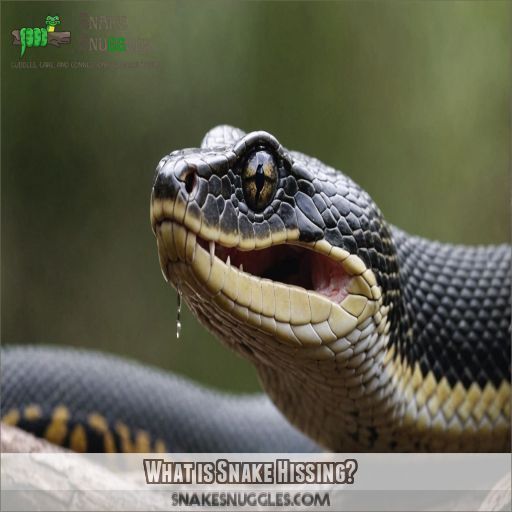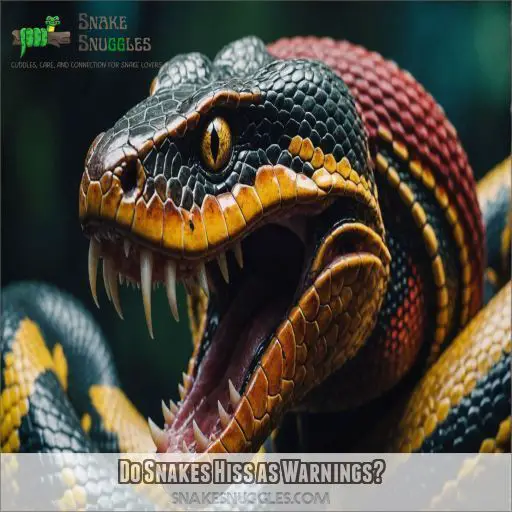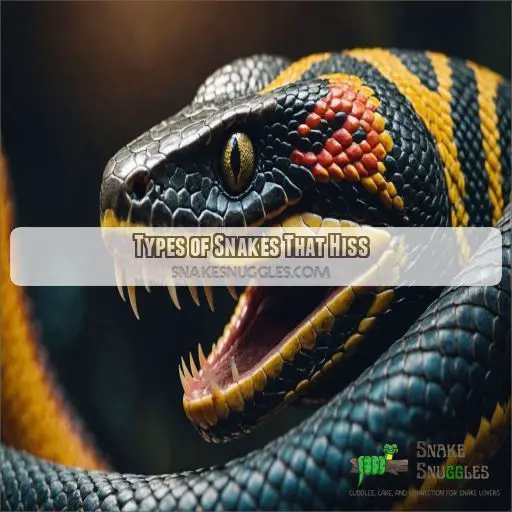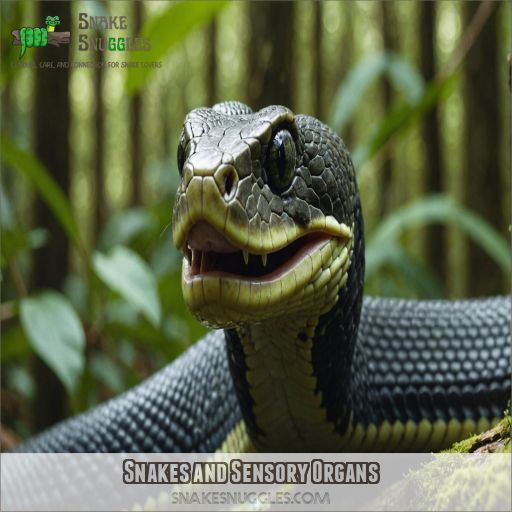This site is supported by our readers. We may earn a commission, at no cost to you, if you purchase through links.
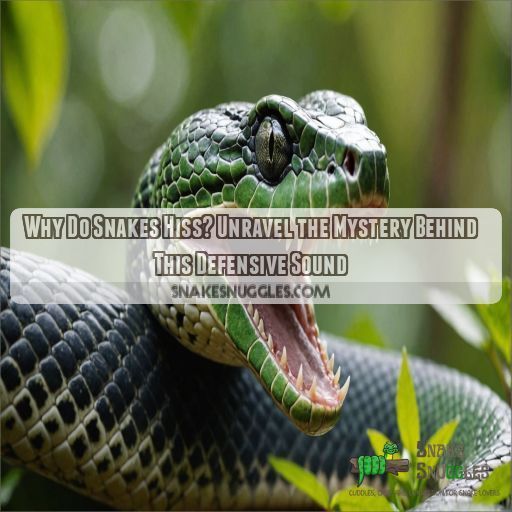 You’re wondering why snakes hiss?
You’re wondering why snakes hiss?
It’s not just a creepy sound effect – it’s a key defense mechanism that helps them stay safe.
When a snake feels threatened or scared, it hisses to warn potential predators to back off.
By forcing air through its glottis, the snake creates a vibrating sound that makes it appear larger and more intimidating.
But that’s not all – the intensity and frequency of the hiss can also convey the snake’s emotions and intentions.
Want to know more about the fascinating world of snake behavior and body language?
You’re just getting started on an intriguing journey!
Table Of Contents
- Key Takeaways
- What is Snake Hissing?
- Why Snakes Hiss at People
- Do Snakes Hiss as Warnings?
- Types of Snakes That Hiss
- Snake Behavior and Hissing
- Snakes and Sensory Organs
- When to Worry About a Hissing Snake
- Frequently Asked Questions (FAQs)
- What does it mean if your snake hisses at you?
- Why do snakes hiss at people?
- Do snakes hiss as warnings?
- Do non-venomous snakes hiss?
- Can snakes control the loudness of their hissing sounds?
- Do baby snakes learn to hiss from their mothers?
- How do snakes use hissing to communicate with each other?
- Can a snakes hissing frequency indicate its emotional state?
- Do snakes ever get tired from hissing too much?
- Conclusion
Key Takeaways
- You’re not alone in wondering why snakes hiss – it’s a key defense mechanism that helps them stay safe, and it’s not just a creepy sound effect. By forcing air through their glottis, snakes create a vibrating sound that makes them appear larger and more intimidating.
- When a snake hisses at you, it’s not just a threat – it’s a form of communication that says, "Back off, I’m feeling uneasy!" Snakes use different hiss variations to convey their emotions, and the intensity of the hiss can indicate how likely they are to strike.
- You might be surprised to learn that snakes can control the volume of their hisses – they do this by adjusting the force of air expelled through their glottis. This clever trick provides an evolutionary advantage, discouraging predators from attacking.
- It’s not just venomous snakes that hiss – non-venomous snakes can also pack a punch with their hissing. Baby snakes are even born with a natural instinct to hiss, so they don’t need to learn it from their mothers. It’s like a built-in defense mechanism that they’re ready to use from day one.
What is Snake Hissing?
You’ve probably heard the unmistakable sound of a snake hissing, but have you ever wondered what’s behind this defensive noise? Snakes hiss as a key survival mechanism to deter predators, and it’s not just a simple reflex – there’s some remarkable science behind how they produce this distinctive sound.
The Science of Snake Hissing
When a snake hisses, it’s not just a random sound – it’s a defense mechanism to deter predators. This clever adaptation has evolved to make snakes appear larger and more intimidating. But what exactly is hissing? Simply put, it’s a warning sign that a snake feels threatened or scared. Think of it like a big, scaly "back off" signal.
How Snakes Produce Hissing Sound
So, how do snakes produce that eerie hissing sound? It’s quite simple, really. Snakes force air through their glottis, causing it to vibrate and create the hissing noise. This air expulsion is the key to the hissing mechanism, and snakes can even control the sound frequency. It’s a remarkable example of snake anatomy in action!
Why Hissing is a Crucial Defense Mechanism
You’re probably wondering why snakes hiss in the first place. It’s actually a clever defense mechanism to deter predators. By forcing air through their glottis, snakes create a hissing sound that makes them seem larger and more intimidating. This predator deterrent has been honed through evolution, giving snakes a key survival advantage and helping them thrive in their environments.
Why Snakes Hiss at People
You’re probably wondering why snakes hiss at people.
The answer lies in their natural defense mechanism.
Snakes hiss to communicate fear, anger, or irritation, and to deter potential threats.
When a snake feels threatened or scared, it will often let out a loud hiss to warn you to back off.
You should understand this behavior to avoid any misunderstandings or potential harm.
Hissing as a Form of Communication
When a snake hisses at you, it’s not just a threat – it’s a form of communication. Think of it like a warning sign that says, "Back off, I’m feeling uneasy!" Snakes use different hiss variations to convey their emotions, and the intensity of the hiss can indicate how likely they’re to strike.
Signs of Fear, Anger, or Irritation
When a snake hisses at you, it’s often a sign of fear, anger, or irritation. Pay attention to body language like raised scales, tense posture, and direct eye contact. Notice the hissing pattern – is it loud and aggressive or soft and warning? Tail movements can also indicate agitation. Recognizing these cues can help you respond safely and calmly.
When Snakes Feel Threatened or Scared
You’re face-to-face with a hissing snake – what now? When snakes feel threatened or scared, they hiss to warn you to back off. Here are 4 key signs to watch out for:
- Raised body posture: The snake lifts its body off the ground, making itself appear larger.
- Direct stare: The snake looks directly at you, indicating it feels threatened.
- Tightened coils: The snake tenses up, ready to strike if needed.
- Increased hissing volume: The snake hisses louder, warning you to stay away.
Do Snakes Hiss as Warnings?
You’re probably wondering if a snake’s hiss is more than just a scary sound – does it actually serve as a warning before the snake strikes?
It turns out that snakes do use hissing as a warning mechanism.
However, it’s just one part of their defensive toolkit.
Understanding what it means can help you navigate encounters with these slithery creatures.
Warning Signs Before a Snake Strikes
You’re wondering if snakes hiss as warnings before striking. The answer is yes, but it’s not the only sign. Check out these warning signs:
| Warning Sign | What to Look Out For |
|---|---|
| Tail-rattling | A rattling or vibrating tail, indicating agitation |
| Body-flattening | A flattened body, making the snake appear larger |
| Defensive-posture | A raised, puffed-out body, or a cobra-like hood |
If you notice these signs, it’s best to slowly back away and give the snake space.
How Snakes Use Hissing to Deter Predators
You’ve learned about the warning signs before a snake strikes, but how do snakes use hissing to deter predators?
By forcing air through their glottis, snakes create a hissing sound that makes them appear larger and more intimidating.
This clever trick provides an evolutionary advantage, discouraging predators from attacking.
It’s a body language cue that says, "Back off, I’m not an easy meal!
Other Defensive Tactics Used by Snakes
You’re wondering if snakes hiss as warnings? Well, it’s not their only trick. Snakes use various defensive tactics to protect themselves. Here are three examples:
- Camouflage: Blending in with their surroundings to avoid detection.
- Tail-whipping: Using their tails to distract predators and create an escape route.
- Biting or constricting: Releasing venom or squeezing tight to immobilize threats.
Types of Snakes That Hiss
You’re probably wondering which snakes are the most notorious hissers – it turns out that pine snakes, hognose snakes, and larger species are particularly good at producing a loud, intimidating hiss. On the other hand, smaller snakes tend to avoid hissing altogether, likely because it’s just not as effective for them.
Notable Hissers: Pine Snakes and Hognose Snakes
Some snake species are renowned for their hissing abilities, employing this tactic as a primary form of defense. Pine snakes, for example, are equipped with adaptations that enable them to produce exceptionally loud hisses. Their hiss, combined with their size, can be quite intimidating. Hognose snakes also utilize loud hisses, often in conjunction with other defensive behaviors, such as striking or playing dead.
| Species | Hiss Intensity | Defense Tactics |
|---|---|---|
| Pine Snake | Loud | Hissing, Striking |
| Hognose Snake | Loud | Hissing, Striking, Death Feigning |
| Small Snakes | Variable | Variable, often silent |
| Large Snakes | Generally loud | Hissing, Visual displays |
Large Snakes and Their Effective Hissing
Size matters when it comes to snake hissing. Larger snakes benefit from a good hiss as a deterrent. Here’s why:
- Intimidation Factor: A bigger snake has more room in its lungs to create a louder, deeper hiss. This creates the impression of an even larger, more dangerous snake, which is effective at scaring off potential threats.
- Evolutionary Advantage: Hissing is a key survival tool for larger snakes. The sound can effectively discourage many predators, giving them pause.
- Multi-Pronged Defense: Larger snakes often combine hissing with other defensive behaviors, like striking or visual displays, for maximum intimidation.
Why Small Snakes Rarely Hiss
Now, let’s address the small fry. Why don’t tiny snakes hiss? Well, it all comes down to size and the effectiveness of intimidation. Smaller snakes, as you’ll see in the table below, tend to rely on other tactics to survive. Hissing, being a size-dependent intimidation tactic, is less effective for them. They’ve evolved to use other tricks to survive, and that’s a smart move when you’re the runt of the litter!
| Snake Type | Size | Hissing | Other Defensive Tactics |
|---|---|---|---|
| Pine Snake | Large | Loud Hisser | Striking, Visual Displays |
| Hognose Snake | Medium | Loud and Proud | Playing Dead, Striking |
| Garter Snake | Small | Rarely Hisses | Burrowing, Speed |
| Thread Snake | Tiny | Silent but Deadly | Camouflage, Secretive |
Snake Behavior and Hissing
You’re about to venture into the fascinating world of snake behavior, specifically, why they hiss. From defensive tactics to sensory wonders, get ready to unravel the mysteries of these slippery creatures and understand their unique language.
Ball Python Hissing: a Closer Look
Ball pythons, like all snakes, use hissing as a form of communication. They may hiss to express fear, anger, or irritation, especially when feeling threatened. Here are three key insights about ball python hissing:
- Ball pythons might hiss when handled too roughly or disturbed while resting. It’s their way of saying, "Back off and let me be!"
- Keep an ear out for hissing frequency and volume. Random hissing or changes in volume could indicate stress or a respiratory infection, so it’s important to pay attention to these subtle cues.
- Hissing can also be territorial, especially in enclosures with multiple snakes. Make sure your pet has enough space to call their own to avoid any hissy fits over territory.
When Ball Pythons Hiss at Owners
When your ball python hisses at you, it’s likely feeling stressed or threatened. Check your handling techniques: are you supporting its body, moving slowly, and avoiding sudden touches? Make sure its enclosure is set up correctly, with proper temperature, humidity, and hiding spots. Consult the table below for common reasons behind ball python hissing.
| Reason | Solution |
|---|---|
| Handling stress | Support its body, move slowly |
| Enclosure issues | Check temperature, humidity, hiding spots |
| Respiratory issues | Consult a veterinarian, make sure proper care is provided |
| Over-handling | Give your snake time to rest, reduce handling frequency |
Territorial Hissing in Ball Pythons
You’ve learned why ball pythons hiss at owners, but what about territorial hissing? When multiple snakes share a small enclosure, they may hiss to mark their territory. Here are some signs to look out for:
- Increased hissing frequency: If your ball python is hissing more than usual, it may be a sign of territorial stress.
- Stress signs: Look for changes in appetite, shedding, or behavior.
- Territory marking: Ball pythons may rub their faces or bodies on surfaces to mark their territory.
- Enclosure size: Provide a spacious enclosure to reduce territorial hissing and stress.
Snakes and Sensory Organs
As you explore the fascinating world of snakes, you’ll discover that their hissing sound is closely linked to their remarkable sensory organs. In this section, we’ll take a closer look at the incredible features that help snakes navigate, hunt, and interact with their environment – and how these senses play a key role in their defensive hissing behavior.
The Snake’s Mouth: a Sensory Wonderland
You’re about to enter a sensory wonderland – the snake’s mouth! This marvel of evolution is designed for both hunting and sensing the world. As you explore, you’ll discover the incredible tongue function, smell detection, and mouth anatomy that make snakes so effective.
| Snake Senses | How it Works |
|---|---|
| Tongue Function | Flicks in and out, collecting scent particles |
| Smell Detection | Delivers particles to Jacobson’s Organ for analysis |
| Mouth Anatomy | Nostrils for breathing, heat-sensing pits for detecting prey |
Jacobson’s Organ: the Secret to Snake’s Navigation
As you explore the snake’s sensory world, Jacobson’s Organ plays a starring role. This tiny powerhouse analyzes scents from the snake’s tongue-flicking adventures, helping it navigate, find prey, and even detect potential mates. By processing chemical cues, Jacobson’s Organ gives snakes a unique edge in their environment, making it a key player in their evolution and survival.
Heat-Sensing Pits: the Extraordinary Feature of Pit Vipers
You’re probably wondering how Pit Vipers detect their warm-blooded prey. It’s all thanks to their heat-sensing pits, an extraordinary feature that’s a game-changer for hunting. These pits use infrared vision to detect thermal imaging, allowing pit vipers to strike with precision. This unique adaptation is a key part of their evolution and hunting strategy, making them expert predators.
When to Worry About a Hissing Snake
You’re probably familiar with the unsettling sound of a hissing snake, but did you know that not all hisses are created equal? Sometimes, a snake’s hiss can be a warning sign of stress, discomfort, or even a underlying health issue, like a respiratory infection.
Hissing Due to Respiratory Infections
If your snake is hissing randomly, it could be a sign of a respiratory infection. Keep an eye out for other symptoms like labored breathing, wheezing, or lethargy. If you suspect an infection, get your snake to a vet ASAP.
- Labored breathing or rapid breathing
- Wheezing or coughing sounds
- Lethargy or loss of appetite
Hissing in Stress or Discomfort
If your snake’s hissing persists and you’ve ruled out a respiratory infection, it’s likely due to stress or discomfort. Check their enclosure for proper temperature, humidity, and lighting. Make sure they’ve a balanced diet and a clean environment. Observe their body language; a stressed snake may exhibit rapid breathing, pacing, or hiding. Addressing these issues can help calm your snake.
Knowing the Signs of a Happy, Healthy Snake
You want to know if your snake is happy and healthy. Here are some signs to look out for:
- A relaxed body posture, with no flattening or tensing up, indicates a stress-free snake.
- Regular feeding habits and shedding patterns are good indicators of overall health.
- A well-maintained enclosure setup, with proper temperature and humidity levels, helps reduce stress indicators.
Frequently Asked Questions (FAQs)
What does it mean if your snake hisses at you?
If your snake hisses at you, it’s likely feeling threatened, scared, or territorial. Check if you’re handling it too roughly or if its environment is stressful. A hissing snake may also be signaling a respiratory infection, so monitor its behavior closely.
Why do snakes hiss at people?
Like Medusa’s warning signal, a snake’s hiss at you is a defense mechanism, signaling fear, anger, or irritation, and it’s their way of saying "back off" to protect themselves from potential threats, including you.
Do snakes hiss as warnings?
When a snake hisses, it’s often a warning sign that it feels threatened, scared, or territorial. Think of it like a big, scaly "back off" signal, telling you to give it some space and respect its boundaries.
Do non-venomous snakes hiss?
You’re curious about hissing snakes—are all snakes created equal in this regard? Well, it turns out that yes, even non-venomous snakes can pack a punch with their hissing.
Can snakes control the loudness of their hissing sounds?
Yes, snakes can control the volume of their hisses. They do this by adjusting the force of air expelled through their glottis, the organ in their throat that creates the hissing sound.
Do baby snakes learn to hiss from their mothers?
Baby snakes are born with a natural instinct to hiss, so they don’t need to learn from their mothers. It’s like a built-in defense mechanism that they’re ready to use from day one.
How do snakes use hissing to communicate with each other?
Did you know 70% of snakes use hissing to warn other snakes of potential threats? As you learn about snakes, you’ll discover they use hissing to communicate fear, anger, or territorial boundaries with each other.
Can a snakes hissing frequency indicate its emotional state?
When a snake hisses, its frequency can reveal its emotional state – think of it as a slithery stress meter! A higher frequency might indicate fear or agitation, while a lower hum could signal a more relaxed, yet still wary, snake.
Do snakes ever get tired from hissing too much?
You’re wondering if snakes get tired from hissing too much? Well, snakes don’t really "get tired" from hissing, but prolonged hissing can lead to respiratory strain, especially if they’re stressed or already have a respiratory infection.
Conclusion
Imagine you’re on a hike and suddenly, a coiled snake hisses at you.
Your heart skips a beat, and you freeze.
This is exactly what the snake intended – to warn you to back off.
By understanding why snakes hiss, you’ll appreciate the intricate defense mechanism behind this sound.
Snakes hiss to convey emotions, intentions, and warnings, making it an important language to decipher.

